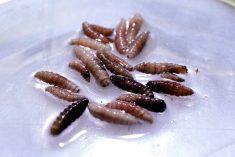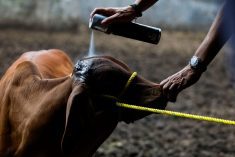Mexico City | Reuters—Mexico’s government said on Monday that it has started to build a $51 million (C$69.8 million) facility in the country’s south as part of an effort to combat screwworm, a pest that has disrupted Mexican exports of cattle to the United States.
Mexico’s agriculture ministry said in a statement that the plant, a joint project with the U.S., will produce 100 million sterile screwworm flies per week once completed in the first half of 2026.
Read Also

U.S. livestock: Feeder cattle hit contract highs on tight supply
Chicago | Reuters – All Chicago Mercantile Exchange feeder cattle futures and most live cattle futures hit contract highs on…
Why it matters: The U.S. shut its southern border to Mexican cattle imports earlier this year due to a case of New World screwworm, reducing already tight cattle stocks.
The release of sterile flies, which reduce the reproducing population of the wild flies, is a key tool in controlling the pest.
The United States, Mexico’s biggest trading partner, is paying $21 million of the cost and Mexico is spending $30 million, the statement said.
The U.S. closed its southern border to imports of certain livestock, including cattle, from Mexico on May 11 after screwworm, which has been eradicated in the U.S. for decades, began moving northward in Mexico.
On June 30, The U.S. Department of Agriculture announced the gradual reopening of imports of cattle, bison and horses from Mexico. Ports are due to reopen in phases starting Monday, beginning with Douglas, Arizona.
The U.S. also announced plans to open a sterile fly dispersal facility in Hidalgo County, Texas, as part of the country’s fight against screwworm.
The pest can infest livestock and wildlife and carry maggots that burrow into the skin of living animals, causing serious and often fatal damage.
—Reporting by Adriana Barrera

















